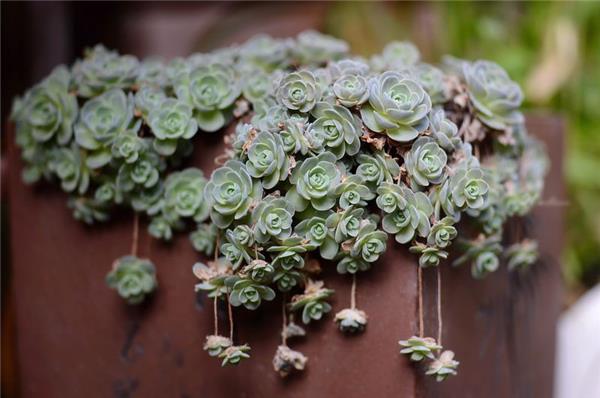Matters needing attention in cultivation and maintenance of succulent plants in July
July is a difficult month for all plants, and even succulent plants who are more tenacious than life can wither or die if they are not properly maintained.

Growth status of different succulent plants in high temperature season in July
Blowing, nail crab, tree ice, Huishan and other tequila plants; most species of cactus, such as golden mound, giant vulture jade, Venus, grass ball, and cactus plants such as dragon god pillar and near guard pillar; Quiwei jade, golden unicorn, wrinkled leaf unicorn, bachelor tree, Euphorbiaceae; desert rose, Huibixiao of Apocynaceae and "summer-type" succulent plants such as gummed hoof jade and Buddha head jade of Apocynaceae are still in the peak growing season this month.
The lying cattle and dinosaurs of the shark genus of the aloe family, and the "intermediate" succulent plants such as rainbow jade and tube leaf flower moon of the crassulaceae grow slowly or basically stagnate in spring and autumn.
On the other hand, most of the varieties of succulent plants in the apricot family, such as the genera Caryophyllum and Corydalis, as well as South African tortoise, spring grass, and broad-leaf spring grass, and Jingye, mountain roses, and small red clothes of the crassulaceae, and the growth of "winter-type" succulent plants such as Vientiane and jade fans of the aloe family stopped completely.
The planting management of succulent plants in July can be carried out according to different species and cultivation environment, but no matter which type of succulent plants should avoid rainstorm and exposure, and have a good ventilated environment.

Maintenance of succulent plants in high temperature season in July
Diseases and insect pests: succulent plants are the easiest to get "root pink scale". This kind of insect is small and difficult to find. The root pink scale lives in the basin all its life, and it will erupt three seasons in a year, such as four seasons in the greenhouse. The root pink scale feeds on plant sap, and black rot is mostly the result of excessive juice absorbed by the root pink scale. Summer is the season of flooding of root pink scale, and succulent plants are in a dormant state, and their resistance decreases, and the superposition of multiple reasons is easy to cause mold outbreak.
Moisture: succulent plants are supposed to be semi-dormant in summer because of high temperatures and drought, and their stomata close during the day because of metabolic habits. If you give them too much water at this time, it will cause them to expand and contract to break the cell wall at high temperature, and the plant leaves will become transparent from bottom to top, which is called "melting water". In addition, the sun exposure time of succulent plants is too long, coupled with insufficient ventilation, using a stuffy way, and finally the leaves will dissolve water.

Fertilization: for plants in the growing season, apply dilute liquid fertilizer every half a month. Other plants do not have to fertilize so often.
Light: enough light for succulent plants to grow normally. Otherwise, they tend to grow in vain or even die. There is too much light in July, and some plants, such as tortoise shell dragon and spring grass, need shade.
Temperature: most succulent plants prefer a warm environment, with luxuriant leaves and flowers in the temperature range of 20 ℃ to 30 ℃. But if the summer is too high, we should also pay attention to indoor ventilation and cooling. They are not resistant to severe cold, and the overwintering temperature should be no less than 10 ℃.

It seems that in this hot season, not only people should take measures to prevent heat and cool down, plants also need ah, I hope everyone can pay more attention to let their succulent people safely through this hot season.
- Prev

Introduction and points for attention of aloe vera in the city that never sleeps
Introduction and points for attention of aloe vera in the city that never sleeps
- Next

Breeding methods and Culture points for attention of Magnolia lanceolata
Breeding methods and Culture points for attention of Magnolia lanceolata
Related
- Wuhan Hospital Iron Tree Blooming Result Was Instantly Frightened by the Gardener Master
- Which variety of camellia is the most fragrant and best? Which one do you like best?
- What is the small blue coat, the breeding methods and matters needing attention of the succulent plant
- Dormancy time and maintenance management of succulent plants during dormancy
- Minas succulent how to raise, Minas succulent plant pictures
- What are the varieties of winter succulent plants
- How to raise succulent plants in twelve rolls? let's take a look at some experience of breeding twelve rolls.
- Attention should be paid to water control for succulent plants during dormant period (winter and summer)
- Watering experience of twelve rolls of succulent plants
- Techniques for fertilizing succulent plants. An article will let you know how to fertilize succulent plants.

